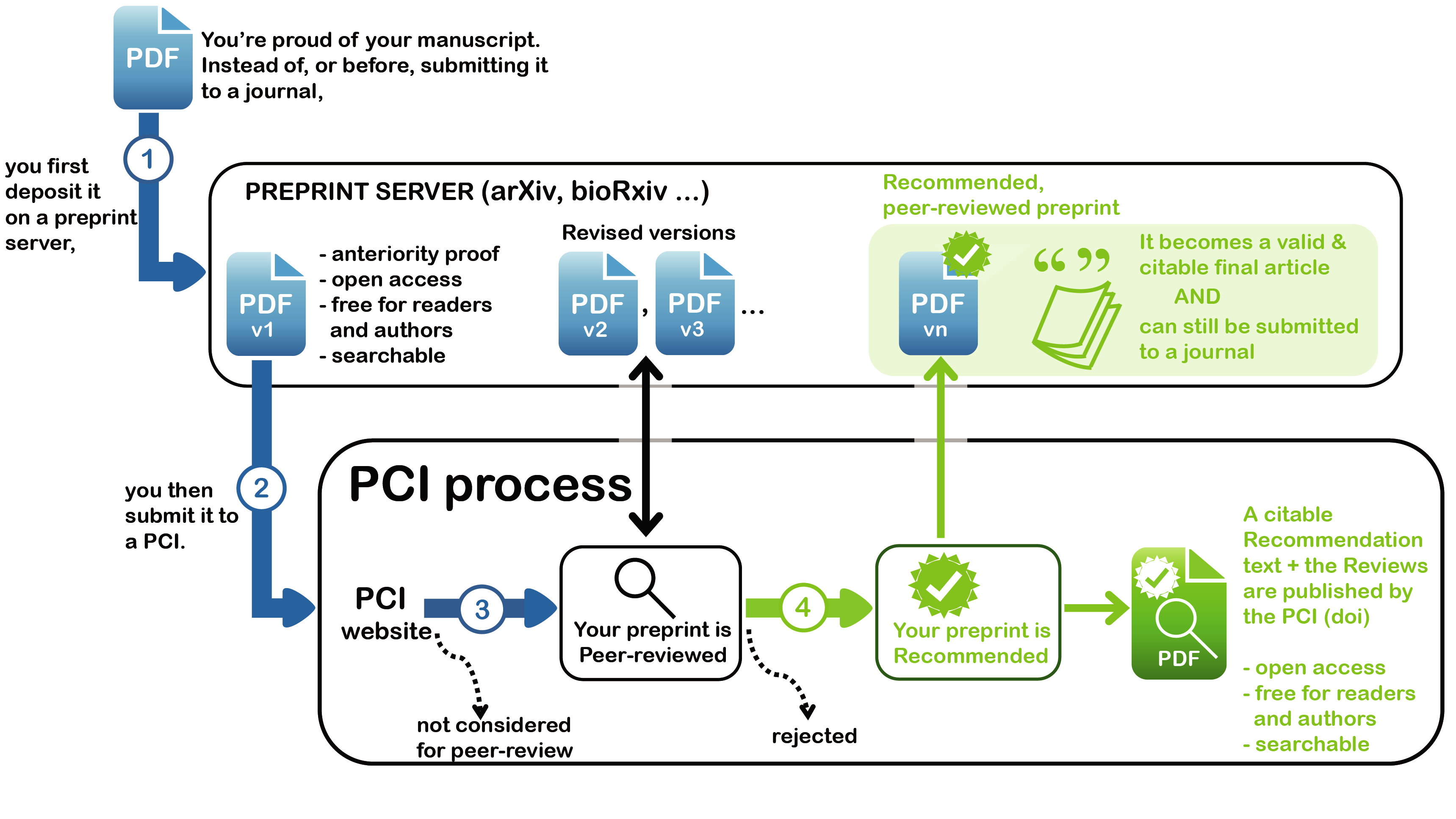1. Workflow

2. General description
PCI Neuroscience reviews and recommends unpublished articles, as complete, reliable and citable articles, without the need for their publication in ‘traditional’ journals. PCI Neuroscience also reviews and recommends preregistrations of studies. Evaluation and recommendation by PCI Neuroscience are free of charge.
The processes of publication in a traditional journal and recommendation by PCI Neuroscience are not exclusive: an unpublished article can be submitted to a journal after its evaluation by PCI Neuroscience. However, simultaneous submission to a journal and to PCI Neuroscience is not permitted. Indeed, preprints submitted to PCI Neuroscience must not be published or submitted for publication elsewhere until the PCI Neuroscience evaluation process has been completed. The article must, therefore, have been rejected or recommended by PCI Neuroscience before it can be submitted to a journal.
3. The evaluation & recommendation process
The process of preprint evaluation by PCI Neuroscience is very similar to the process of article evaluation in ‘traditional’ journals. Just like journal editors, the recommenders appointed by PCI Neuroscience handle preprints: they are responsible for finding reviewers, collecting reviews, and making editorial decisions based on reviews. They may eventually recommend articles after one or several rounds of review. Preregistration recommendation works in a similar way, with one recommender appointed to handle the preregistration and a few reviewers to judge the value of the proposed study.
When recommenders decide to recommend a preprint, they write a recommendation. This recommendation is essentially a short article, similar to a News & Views piece, describing the context of the study and explaining why this article is particularly interesting. This recommendation and all the editorial correspondence (reviews, recommender's decisions, authors’ replies) associated with the recommended article are published by PCI Neuroscience. The article itself remains in the open archive and is not published by PCI Neuroscience. In the case of preregistration recommendations, the recommender also writes a short recommendation summarizing the strengths of the proposed studies and the recommendation is associated with the reviews and correspondence with the authors.
The recommendation by PCI Neuroscience increases the value of the recommended article. Recommended articles can be used by scientists and cited in the scientific literature. There is no need for these recommended articles to be published in traditional journals (although they can be, according to the authors’ preferences). Recommendation of a preregistration can pave the way for recommendation of the article describing the results of the study, once it is written. Essentially, sticking to the preregistration plan streamlines the process of recommending the article.
As PCI Neuroscience does not copy-edit articles, authors should pay careful attention to typographical and other errors. A recommended article should be as close to perfect as possible in form because it is a finished article. The presence of all tables and figures, additional materials and accessibility of the data must be checked.
PCI Neuroscience publishes the recommendations written by recommenders, but we do not host or format neither the articles nor the preregistrations we recommend. Instead, we simply link the recommendation to articles posted in open archives, such as bioRxiv1 or arXiv, or to preregistrations hosted on appropriate platforms (GitHub, etc.). The costs of the process of evaluation and recommendation and of hosting the website are very low. As a result, there are no charges for authors (or for readers, because the recommended articles can be downloaded, for free, from preprint servers).
Some institutions require authors to deposit their Author Accepted Manuscript (AAM) on institutional repositories. This is the case, for example, for Oxford University or the CNRS, which have open-access policies requiring researchers to deposit their accepted manuscripts in the Oxford University Research Archive (ORA) and HAL, respectively. In such cases, we advise authors to deposit the version of the preprint recommended by PCI in the institutional repository.
4. What does PCI do?
4.1 At submission, PCI
- Considers all types of articles (experimental work, theory, review, opinion, etc.)
- Does not impose any format or restrictions in terms of article length, number of figures or tables
- Considers anonymous submissions
- Welcomes reproductions of studies
- Welcomes preregistration submissions and preprint submissions based on preregistrations (with or without prior review)
- Welcomes preprints reporting negative results, provided that the questions addressed and the methodology are sound
- Checks articles for plagiarism with IThenticate
- Checks articles for the absence of conflict of interest
- Makes sure that raw data, codes and scripts are available
- Checks that the article is readable (figures)
- Checks the compliance of the article with ethical standards
- Helps authors to suggest appropriate recommenders to handle their article
- Informs authors within 20 days if no recommender can be found to handle the article
4.2 During evaluation, PCI
- Evaluates only articles considered interesting by at least one of the many recommenders
- Provides explicit guideline for the recommender handling the preprints (https://peercommunityin.org/2020/10/28/pci-recommender-guide/)
- Organizes rigorous peer review (https://peercommunityin.org/2020/10/22/pci-reviewer-guide/) for selected articles
- Tries to keep delays as short as possible by sending reminders to reviewers and recommenders to ensure that the necessary tasks are completed promptly
- Provides technical assistance to authors, recommenders and reviewers
- Allows authors to follow the evaluation process of their article online
- Makes sure that recommenders obtain at least two reliable review reports before making editiorial decisions on the original version of the article
- Makes sure that recommenders make an editorial decision that is reliable and respectful to the authors
4.3 At the revision stage, PCI
- Communicates regularly with the authors to ensure that the revision process is performed correctly and in a timely manner for the preprint concerned.
- Allows the authors as much time as they need to revise their article
4.4 In case of recommendation, PCI
- Publishes an open-access citable recommendation with a DOI relating to the entire editorial process (reviews, editorial decisions, author's replies)
- Provides authors with a template for formatting the recommended version of their article
- Creates OpenCitations and machine-readable metadata for recommendations
- Provides authors with transferable reviews if the article is not recommended
4.5 After recommendation, PCI
- Does not require any transfer of copyright
- Allows authors the choice as to whether to submit the recommended preprint to a journal
- Provides authors with suggestions as to how to submit their recommended article to a journal if they wish to do so
- Archives the editorial process (including recommendations) in CLOCKSS
- Archives the editorial process (including recommendations) in HAL
- Promotes the recommended article and the recommendation on social media (Twitter, Facebook, Instagram)
- Indexes the editorial process (including recommendations) in Europe PMC, bioRxiv, sciety, Google Scholar
- Displays the Altmetrics data of the article and the recommendation
- Displays the link to the article with the recommendation
5. Fate of PCI-recommended preprints: PCI-friendly journals and the Peer Community Journal
The goal of PCI is to evaluate and recommend preprints, converting them into valid, citable final articles. The theoretical outcome is for PCI-recommended preprints to remain on preprint servers.
However, for various reasons, the authors of PCI-recommended preprints may prefer:
-To submit their preprint to a PCI-friendly journal (accepts the article with no further peer review, or provides the authors with a response in usually less than 5 days, or uses the PCI evaluation if appropriate)
-To submit their preprint to the Peer Community journal (published as is, free of charge)
-To submit their preprint to another journal

In the case of PCI submissions being recommended and eligible for multiple journals, the authors will make the final decision as to where the manuscript should be published. The journal chosen may be any PCI-friendly journal, other journals, or no journal if the authors prefer the article to be hosted solely on their preferred preprint server. In all cases, the reviews and decision letters for recommended submissions will be published on the PCI platform.
5.1 PCI-friendly journals
PCI-friendly journals make three types of commitment concerning PCI assessments:
5.1.1 Journals committed to accepting PCI-recommended articles without further peer review
- These journal endorse the PCI review criteria and agree to accept, without further peer review, any manuscript obtaining a positive final recommendation from PCI while also meeting any additional procedural requirements that do not require further scientific evaluation by these journals. Such additional requirements could include falling within a defined disciplinary scope.
- Note that subjective judgments about the importance, novelty or timeliness of a research question are not relevant to the judgment of research quality at PCI and are not assessed as an additional requirement by these journals.
- These journal accept PCI recommended articles for publication even if the reviews performed by PCI are anonymous.
- Similarly, these journals will not relitigate any scientific elements of the study that PCI has already approved.
- These journal agree to display clearly, on the homepage of the article, a note indicating that the evaluation process was carried out by PCI of the following type:
Editor's note: This article has been reviewed and recommended by Peer Community in Evolutionary Biology: Mathieu Joron (2020) Studying genetic antagonisms as drivers of genome evolution. Peer Community in Evolutionary Biology, 100108. https://doi.org/10.24072/pci.evolbiol.100108
5.1.2 Journals providing authors with a fast response
- These journals do not automatically accept PCI-recommended articles, but have agreed to the following commitment: once the article is submitted by the authors, the journal agrees to provide the authors with one of the following three responses, within a specified short turnaround time (e.g. 5 days):
- Acceptance with minor modifications with no further peer-review,
- Need for further peer-review before decision,
- Not interested.
- In case of acceptance, these journals agree to display clearly on the homepage of the article a note indicating that the evaluation process was carried out entirely or partly by PCI, of the following type:
Editors' note: A previous version of this article was reviewed and recommended by Peer Community in Evolutionary Biology: Mathieu Joron (2020) Studying genetic antagonisms as drivers of genome evolution. Peer Community in Evolutionary Biology, 100108. https://doi.org/10.24072/pci.evolbiol.
5.1.3 Journals committed to using PCI evaluations if appropriate
- These journals do not automatically accept PCI-recommended articles but have agreed to the following commitment: The journal will consider submissions of articles recommended by a PCI and they may use PCI reviews and recommendations for their own review processes, if appropriate.
- In case of acceptance, these journal agree to display clearly on the homepage of the article a note indicating that the evaluation process was carried out entirely or partly by PCI, of the following type:
Editors' note: A previous version of this article was reviewed and recommended by Peer Community in Evolutionary Biology: Mathieu Joron (2020) Studying genetic antagonisms as drivers of genome evolution. Peer Community in Evolutionary Biology, 100108. https://doi.org/10.24072/pci.evolbiol.100108
5.2 The Peer Community Journal
Once an article is recommended by a PCI, the authors can opt to publish their article in the Peer Community journal.
This Peer Community journal is
- Unique = a single journal for all PCIs
- Free = diamond open access (free for authors and for readers).
- Exclusive = Publishes only preprints recommended by PCI
- Unconditional = can publish all PCI recommended articles without further modification
- Opt-in = only if the authors wish to publish in it
- Immediate = no delay between submission and publication
This journal, created and funded by the PCI organization, is hosted by a not-for-profit publisher.
The Peer Community journal does not provide of copyediting or typesetting services.
The Peer Community journal is currently being evaluated by an international scientific database for indexing.









